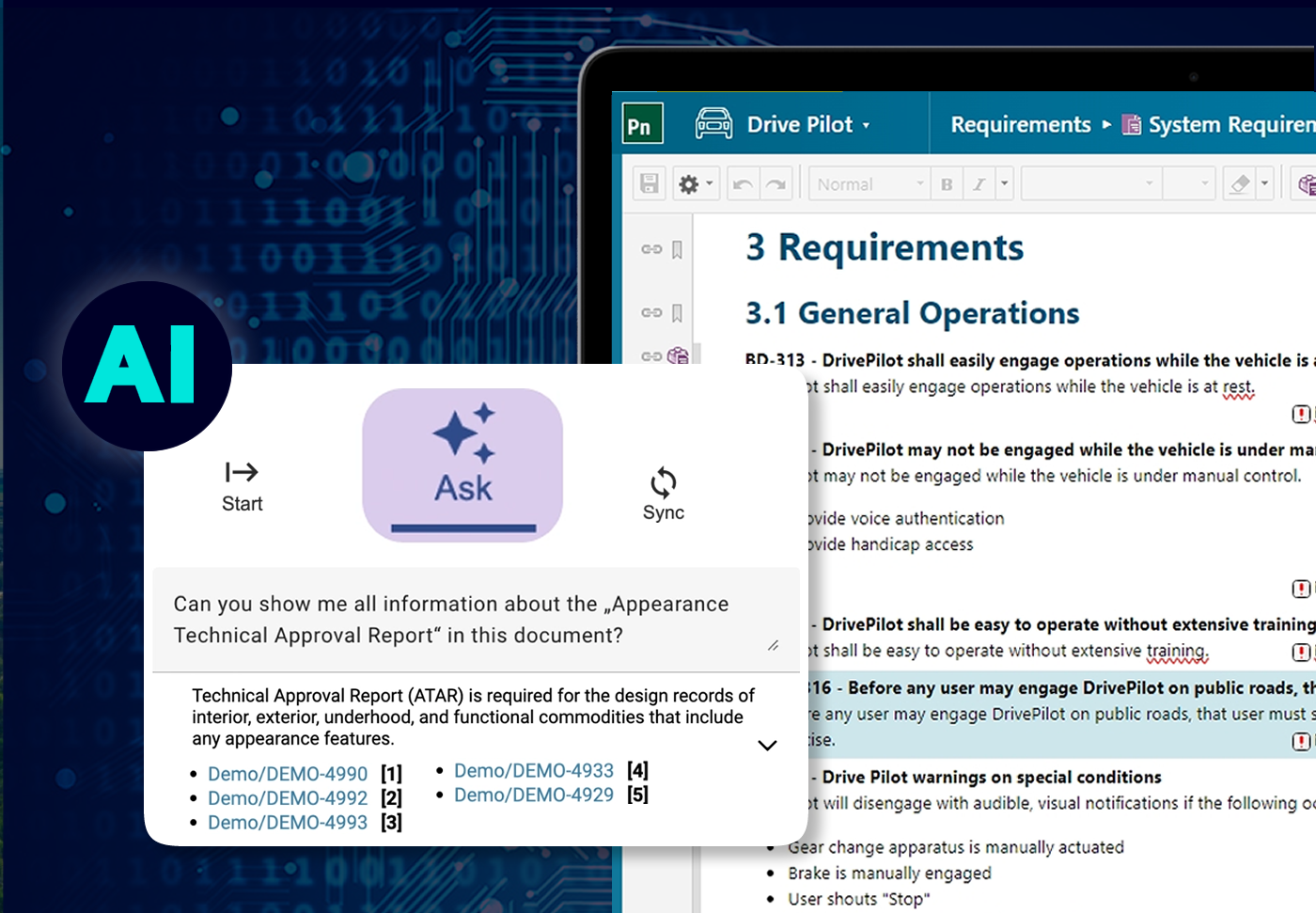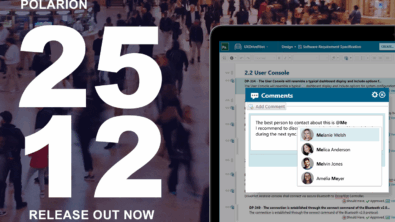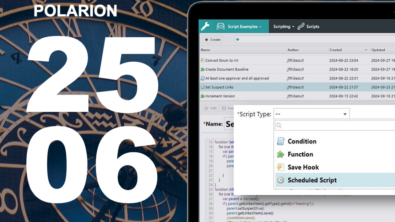How AI can revolutionize requirements evaluation

In the past year, artificial intelligence has surged into the spotlight, becoming a prominent topic on our agendas. It’s not just a buzzword anymore – natural language-based models are making AI available to everyone at a disruptive pace. Not only does this revolutionize the way we work, it also represents a turning point for software. It is therefore all the more important to embrace this development and harness the potential that using AI brings to our daily work — especially in areas like requirements management, where manual and repetitive tasks slow down processes. Let’s specifically look at how AI supports users in tackling challenges in requirements evaluation and how it can help to solve them in Polarion ALM.
Complex requirements, less time
Managing requirements is a critical and time-sensitive process. When suppliers receive new specifications from their customers, the pressure is on to respond quickly and efficiently to stay competitive. However, this is easier said than done. Engineers must read, check, and evaluate a large number of stakeholder needs and customer requirements manually. Even though the content is only slightly different from previously reviewed specifications. The key challenges can be summarized as follows:
- Extensive effort: Manually reviewing and linking requirements is, above all, repetitive work that requires a lot of effort and is very time consuming.
- Time pressure: While the time to respond to the customer is getting shorter, requirements are becoming more complex.
- Risk of human error: Humans are not machines. Tasks such as requirements analysis are particularly prone to error.
- Lack of experienced professionals: The expertise needed for evaluation is often solely located in the heads of experts, who are becoming scarcer for demographic reasons.
Faced with these challenges, it’s obvious that handling requirements without automation is no longer an option.
Knowledge-driven requirements analysis with AI
At first glance, there is a logical explanation for processing new stakeholder needs and customer requirements in manual steps: They are usually worded differently, which makes automation difficult. However, this is exactly where AI can unfold its full potential. Adaptive AI, utilizing technologies such as Large Language Models (LLMs), can read and understand large amounts of text – regardless of wording or language. Without training or expensive fine-tuning, it is possible to quickly compare and analyze any kind of stakeholder needs or requirements on a semantic level. What would take a requirements engineer several hours to accomplish, AI can do in seconds.
In practice, this leads to a highly valuable use case: There is an enormous amount of knowledge from previous requirements projects. It’s like a treasure chest of valuable insights that just wants to be unlocked with the help of AI. These insights can serve as a foundation for evaluating new stakeholder needs and requirements. By transferring the data to Polarion ALM via AI, users can automatically compare new requirements on a semantic level with previously evaluated ones and receive a list of matching requirements – along with all related information and references. This provides users with a shortcut for evaluating requirements and updating their attributes and links with just a few clicks, all while maintaining full control over their analysis results.

Polarion ALM and AI – a powerful synergy
While Polarion ALM offers a comprehensive solution for managing the entire requirements lifecycle with full traceability, AI can be seamlessly integrated as an extension. This allows users to leverage AI capabilities within their familiar working environment and adhere to common workflows. The fact is, incorporating AI-driven features not only enhances the quality of the requirements management process but also improves decision-making and collaboration among project stakeholders.
Evaluating stakeholder needs with an AI boost is just the beginning. With the help of LLMs, it will be possible to support many other process steps throughout the lifecycle in the near future, such as requirements or software code generation and quality checks. Close cooperation between customers and partners is needed in order to discover further features and thus drive forward the development of modern AI-driven requirements management.
Do you want to learn more about how Polarion ALM and their partner thingsTHINKING are solving the challenges in requirements management using AI? Check out the semantha extension in Polarion’s extension portal or visit the following website: https://www.semantha.de/polarion/
Comments
Leave a Reply
You must be logged in to post a comment.



Great Information Of AI So Many Blogs Are Recommend from You Thank you
Generative Ai Training In Hyderabad
Fake Crypto Sender
A “Thank You” message is a gesture of appreciation and gratitude. It serves to acknowledge and express thanks for someone’s effort, kindness, or support. Whether it’s for a small favor or a significant contribution, a well-crafted thank you note can enhance relationships, show respect, and convey sincere feelings.
wedding planner in hyderabad
Thank youGenerative Ai Training in Hyderabad
This blog is very interesting, highly informative, and extremely helpful.
UCAT Coaching in India
CyberArk is an information security company that provides technology like network vaults to customers. It is used to secure accounts and passwords that are highly sensitive and confidential.
good keep posting
Data Science In Healthcare
laitoncrafts is dedicated to creating products that make the places where we live and work more meaningful by developing high-quality products built on a foundation of heritage values, innovation and craftsmanship.the laiton-crafts traditional craftsmanship with modern design, offering a diverse portfolio of products, including Brass Embellishments, Handles, Wall Murals, Partition Grills, Thresholds, Name Plates, Main Doors, and Pooja Doors.
good keep posting
Data Science Course in Hyderabad
good keep posting this kind of content
data science libraries in python
This article offers a compelling look at how AI elevates requirements evaluation in Polarion ALM—especially by transforming repetitive, error-prone tasks into streamlined, knowledge-driven workflows. The integration of Large Language Models to semantically compare new requirements with past ones truly unlocks a ‘treasure chest’ of insights. It’s an inspiring read for anyone exploring AI-enhanced requirements management.
https://certificationmantra.in/pmp-certification-training-in-hyderabad/
This article offers a compelling and forward-looking vision for applying AI to one of engineering’s perennial bottlenecks—requirements evaluation. The way it frames the core challenges—like manual repetition, escalating complexity, tight deadlines, and the looming scarcity of seasoned analysts—really resonates and underscores how unsustainable traditional approaches have become
Siemens Blog Network
.
What I find especially powerful is the idea of unlocking “hidden treasure”: AI leveraging past requirements as a knowledge base for semantic comparison with new specs. Being able to instantly suggest relevant links, references, and updates to attributes transforms what used to be hours of tedious work into seconds, all while keeping humans firmly in the decision-making loop
Siemens Blog Network
.
The seamless integration of AI into Polarion ALM is another highlight. Embedding LLM-driven capabilities into a familiar environment ensures minimal disruption while enhancing traceability, decision-making, and collaboration across project stakeholders
Siemens Blog Network
. Plus, hinting at future features—like AI-assisted requirements generation, code suggestions, and quality checks—hints at a rich roadmap ahead
Siemens Blog Network
.
Altogether, this blog does a great job of demonstrating the real-world value of AI—not as a buzzword, but as a practical accelerator in requirements management. It balances thoughtful vision with grounded relevance. I’m eager to see how this evolves—and particularly interested in hands-on experiences with the semantha extension in Polarion’s portal.
generative ai training in hyderabad
Really insightful piece—AI’s ability to semantically compare new requirements against past ones transforms tedious evaluation into high-speed, error-free productivity. Integrating Large Language Models into Polarion to unlock knowledge from previous projects is a practical game-changer. I’d be keen to see how this evolves—especially scenarios showing AI-assisted link suggestions or predictive attribute mapping in action. Generative Ai Training in Hyderabad
Generative AI Training in Hyderabad At SkillMove, we offer more than just classes — we focus on making sure you really understand and apply what you learn. Our Generative AI Training in Hyderabad is carefully designed to help beginners and professionals master the latest AI tools and techniques, no matter where they’re starting from.
Really interesting read! It’s impressive how AI can help evaluate requirements faster and more accurately. Using past data to improve decision-making seems like it could save a lot of time and reduce errors.
stock marketing Training in Hyderabad
This piece does a great job of showing how AI isn’t just hype — it can have very real, practical value when applied to requirements management. The idea that a tool like Polarion ALM (augmented with AI) can take tedious, error-prone tasks — reviewing, linking, comparing large sets of requirements — and turn them into something near-instant is compelling.
<a href="https://promptacademy.in/prompt-engineering-course-in-hyderabad/"prompt engineering course in Hyderabad
Great insights! Siemens continues to lead with innovative technologies that truly shape the future of automation and digital transformation.
Join Unique Champs Chess Foundation for expert online chess classes & coaching. Learn chess at home or in Hyderabad — Attend a free demo class today!
chess online classes
Great information on AI, Check out aimkreations.com how AI transformed advertising and marketing. Aim Kreations – Best AI Video Production Company in Hyderabad
Great information on AI, Check out aimkreations.com how AI transformed advertising and marketing. Aim Kreations – Best AI Video Production Company in Hyderabad https://aimkreations.com/
The way Polarion ALM taps into past projects and uses AI to semantically compare new requirements with earlier ones feels a lot like how a well-designed HMS quietly connects departments in a hospital: the heavy lifting happens in the background so experts can focus on high‑value decisions. It is exciting to see how features like similarity analysis, automated linking, and future AI-assisted generation could reshape everyday requirements engineering, not as hype, but as genuinely useful assistance built into existing workflows.